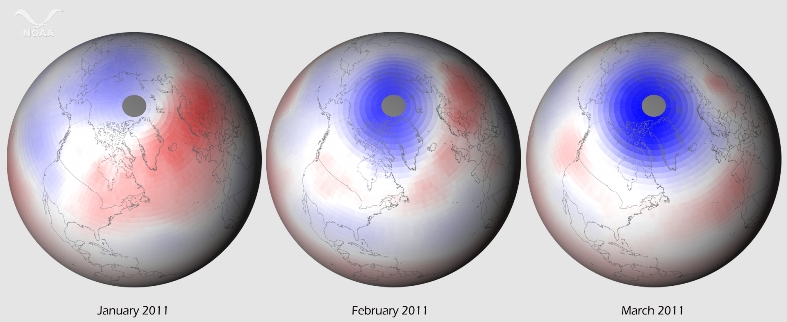|
Unusually Chilly Stratosphere Behind 2011′s Record Arctic Ozone Hole
October 18 2011 NOAA- Check the
fine print on many cans of hairspray or shaving cream these days, and you’ll
probably find a reassurance that the product you are holding contains “No CFCs
or chemicals known to harm the ozone layer.” Located in the stratosphere, the
ozone layer protects life on Earth from the harmful effects of ultraviolet
radiation. To stop ozone destruction, chemical manufacturers phased out the
production of CFCs (short for chlorofluorocarbons) over the past two decades. So why is it that this past
spring, scientists observed the largest, most severe ozone destruction ever
witnessed in the Arctic since records began in 1978? In part, it’s because CFCs
stick around in the atmosphere for a very long time. But the maps above reveal
the main reason this winter’s Arctic ozone loss was so much worse than it
normally is: unusually persistent cold temperatures. From January through March 2011, monthly average temperatures in the Arctic stratosphere were colder than usual. Places where temperatures were up to 9 degrees Celsius warmer than the long-term average (1979-2009) are red, while places where temperatures were up to 16 degrees cooler than average are blue. Colder-than-usual temperatures dominated the stratosphere all three months, especially in March. What does the cold have to do
with the ozone hole? Extreme cold allows clouds to form in the stratosphere,
even though the air there is extremely dry. The clouds make rare chemical
reactions possible. Normally, when CFCs break down, the chlorine they release
gets incorporated into very stable molecules that don’t react with ozone. But on
the surface of particles in these unusual ice clouds, the stable molecules are
converted into forms of chlorine that are much more reactive. In general, the colder the
stratosphere is over the winter, the more of the reactive, ozone-destroying
chemicals that build up. The return of the Sun to the polar regions in the
spring triggers the ozone-destroying reactions. However, once the temperatures
begin to warm up, fewer stratospheric clouds form, and the creation of
ozone-destroying forms of chlorine slows. The ozone loss bottoms out for the
season, and the ozone layer gradually regenerates over the summer. (Ozone
naturally forms when oxygen is exposed to ultraviolet light.) In the Antarctic, winter
temperatures in the stratosphere are persistently cold enough to create polar
stratospheric clouds—and a large, severe ozone hole—every year. In the Arctic,
however, ozone loss has generally been much more limited, so much so that
scientists usually don’t even refer to the annual dip as a “hole.” But this past year, scientists
observed a startling change: the amount of ozone in the Arctic stratosphere
declined to surprisingly low levels—severe enough that scientists described it
as an ozone hole. Within the hole, more than 80 percent of the ozone between 18
and 20 kilometers altitude had been destroyed by the end of winter, according to
an analysis of the event by an international team of scientists. The persistently cold
temperatures were linked to the strength of the polar vortex, a high-altitude
cyclone of very cold air and swirling winds. The circling winds formed a barrier
that prevented Arctic air (and the ozone-depleting gases) from escaping the
region. A vortex forms in both polar regions each winter season. The vortex that
encircled the North Pole region this past winter was the strongest polar vortex
seen in either hemisphere in the last thirty years. The scientists aren’t sure why
the cold temperatures lasted so long in 2011, and they cannot yet predict if or
when Arctic ozone holes will occur in the future. Rising greenhouse gas
concentrations are warming the lower atmosphere, but they are cooling the
stratosphere. The cooling trend raises the possibility of more frequent or
severe Arctic ozone holes in the future. More Arctic ozone holes could pose
health concerns. The Arctic and high latitudes of the Northern Hemisphere are
far more populated than the Antarctic, so Arctic ozone loss has the potential to
expose more people to harmful UV radiation. Stratospheric temperature anomaly
data from the Advanced Microwave Sounding Unit (AMSU) on board NASA’s Aqua
spacecraft. Anomalies are calculated using inter-calibrated climate data
recorded by microwave sounding unit sensors flown on several satellites since
1978. Maps by Dan Pisut, NOAA Environmental Visualization Laboratory. Caption by
Caitlyn Kennedy. References
|








